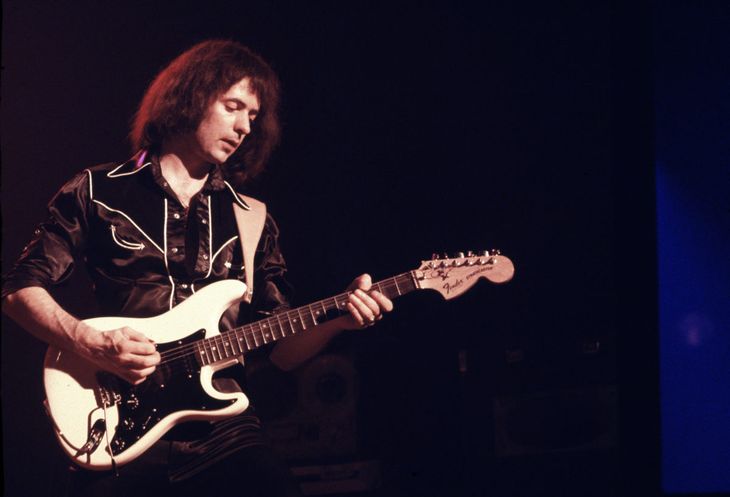At the beginning the sound of the band was focused on psychedelic rock, the progressive and pop of the 1960s. His debut album, “Shades of Deep Purple”included the single “Hush”which had enough impact. However, their following works did not have the expected success.
In those early years, Jon Lord He was the leader and main composer of the group, while Blackmore only added some riffs. Blackmore, Lord and Paice decided to change the musical direction of Deep Purple, so they dismissed Evans and Simper and replaced them with Ian Gillan and Roger Glover.
Blackmore with Ian Gillan, Jon Lord, Roger Glover and Ian Paice gave life to the training known as “Mark II”this alignment would become an unstoppable force in the Hard Rock scene, defining the genre with seminal albums as “In Rock” and “Machine Head”.
Deep-Purple-1972.jpg
“Mark II”, the most popular Deep Purple formation.
The unmistakable sound of Deep Purple was a powerful amalgam of Blackmore virtuosity on the guitar, the powerful voice of Gillan and the rhythmic solidity of the band. Topics like “Highway Star”, “Black Night” and “Space Truckin ‘” They became generational hymns, ciming the reputation of Blackmore as one of the most influential and respected guitarists on the planet.
Despite success, intense musical chemistry did not always translate into personal harmony. Over the years, internal tensions within Deep Purple became noticeable, especially between Blackmore and Gillan. His divergent musical visions and his strong personalities led to several comings and goings of both members, marking different eras in the history of the band.
Blackmore’s relationship with his former companions, in general, has been described as distant and sometimes conflictive. Despite the indelible legacy they built together, the sporadic meetings of classical formation were always wrapped in an aura of uncertainty and tension, feeding the legend of a musical genius with a complex personality.
The roar of the lake: the genesis of “smoke on the water”
Among the vast Deep Purple catalog, a song resonates with a particular iconic force: “Smoke on the Water”. This rock hymn, with its unmistakable and repetitive guitar riff, has become synonymous with the genre and a fundamental piece for any candidate for guitarist. The story behind its creation is as fascinating as the song itself.
During a band’s stay in Montreux, Switzerland, to record his album “Machine Head”a fire in the local casino, caused by a flaw launched during a concert of Frank Zappathe sky filled with a dense smoke on Lake Lemán. This surrealist event inspired the band members, with Blackmore creating the memorable Riff almost by chance during a sound test. The lyrics, later written by Gillan, tells the events of that fateful night, transforming a chaotic incident into a timeless masterpiece that continues to electrify audiences around the world.
The simplicity and power of the Blackmore riff They demonstrated their ability to create memorable and enduring melodies with an economy of amazing notes.
Rainbow, and the comings and turns with Deep Purple
After a first departure from Deep Purple in 1975, Blackmore soon forge a new musical path with the creation of Rainbow. This band became a vehicle for its artistic vision, allowing him to explore a more melodic sound already with classical influences, while maintaining the power of the hard rock.
Over the years, Rainbow had a succession of talented vocalists, including Ronnie James Dio, Graham Bonnet and Joe Lynn Turnereach contributing their own style to the music of the band. Albums like “Rising”, “Long Live Rock ‘N’ Roll” and “Difficul To Cure” They are considered classics of the genre, presenting the unmistakable Blackmore guitar on epic issues such as “Stargazer”, “Man On The Silver Mountain” and “Since You Been Gone”. Blackmore’s ability to create memorable riffs and virtuous solos, combined with the vocal power of its different singers, consolidated Rainbow as an important force in the rock scene.
Ritchie-BlackMore.jpg

Ritchie Blacmore, one of the most influential rock guitarists.
In 1984, Blackmore and Glover (since 1980 part of the band) dissolved Rainbow to reform Deep Purple with Jon Lord, Ian Paice and Ian Gillan. The first album after the group meeting was “Perfect Strangers”published that same year; who followed “The House of Blue Light” In 1987. During the promotional tour, the guitarist was several times to play his flagship song, “Smoke on the Water”. On the other hand, his relationship with Gillan tightened again, after discussions, dismissals and returns Blackmore definitely abandoned the band in 1993.
After his definitive departure of Deep Purple, Blackmore did not stop in his search for new musical horizons. In 1997, together with the vocalist Candice Nighthe gave a radical turn to his sound with the formation of Blackmore’s Night. This project explored Renaissance music and folkshowing a completely different facet from the guitarist. With acoustic instruments, ethereal melodies and lyrics inspired by history and folklore, Blackmore’s Night demonstrated the versatility and musical curiosity of its leader.
In recent years, Blackmore has kept his passion for music alive, alternating between sporadic presentations of Blackmore’s Night and, to the surprise of many, his Rock with a new Rainbow incarnation in 2016. These presentations revived classics from their golden age, demonstrating that the spark and the mastery on the guitar were still intact.
When celebrating its eighth birthday, Ritchie Blackmore stands as a living legend of music. Its impact on rock is undeniable, its legacy as an innovative guitarist and visionary composer impacted guitarists such as Eddie van Halen, Steve Vai, Yngwie Malmsteen or the Argentine Walter Giardinoamong many others.
From Deep Purple’s incendiary Riffs to the Blackmore’s Night evocative melodies, its musical journey has been a constant exploration of sounds and emotions.
Source: Ambito
I am an author and journalist who has worked in the entertainment industry for over a decade. I currently work as a news editor at a major news website, and my focus is on covering the latest trends in entertainment. I also write occasional pieces for other outlets, and have authored two books about the entertainment industry.




